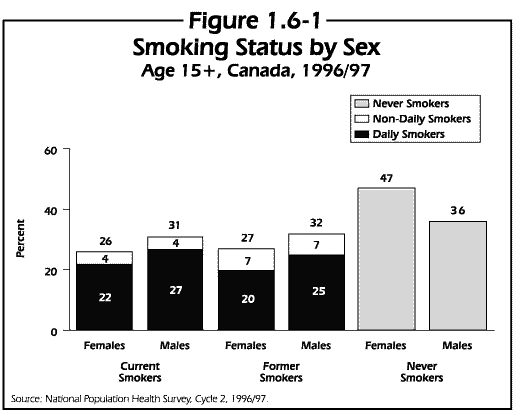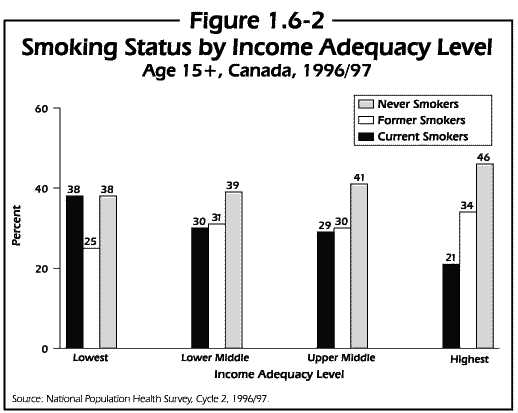Centre for Chronic Disease Prevention and Control
Cancer

Smoking Behaviour of Canadians
Cycle 2, 1996/97 (January 1999, No. 1)
Profile of Canadians who Smoke
Prevalence and Amount Smoked
In 1996/97, over 6.7 million Canadian residents aged 15 and older smoked. This
represented 29% of adults aged 15 and over, a prevalence slightly lower than the 31% smoking prevalence observed
among adults aged 15 and over in the National Population Health Survey (NPHS) in 1994/95 (Cycle 1).
In 1996/97, 25% of adults smoked every day, and an additional 4% were occasional
smokers. More males than females were daily smokers, though the same percentage of females and males smoked only
occasionally (Figure 1.6-1). Canadian
adults who smoked every day reported smoking an average of 18 cigarettes. Males reported smoking more cigarettes
than females (19 vs. 16 cigarettes/day respectively). Both sexes were equally likely to have quit (51% of
ever-smokers).

Provincially, the prevalence of smoking ranged from a low of 26% in British Columbia
and Ontario to highs of 34% in Quebec, and 33% in Nova Scotia and Prince Edward Island. Those provinces with higher
prevalences, such as Quebec, Nova Scotia, New Brunswick and Prince Edward Island, also reported the highest average
number of cigarettes smoked per day by daily smokers. British Columbia, Ontario, and Manitoba exhibited lower daily
smoking prevalences than other provinces and lower averages for the amount smoked by daily smokers.
Income Adequacy and Education Level
The prevalence of smoking among those aged 15 and older was inversely related
to income adequacy (an indicator of socio-economic status derived by Statistics Canada that takes into account
both household income and household size). As shown in Figure 1.6-2, there were nearly twice as many current smokers in the lowest income adequacy group
as there were in the highest (38% vs. 21% respectively). A similar pattern was seen for different education levels.
Thirty-three percent of those with less than secondary school education were current smokers, compared with 23%
of those with a college or university education.

At all income adequacy and education levels, slightly more males than females
smoked on a daily basis. About 4% of respondents in each education and income adequacy category reported smoking
only occasionally.
There was little difference in the average amount smoked per day across the various
income adequacy and education levels. The average number of cigarettes smoked per day was consistently higher for
males than females, except in the lowest income adequacy group, in which both sexes reported smoking the same amount
daily.
Income adequacy and education levels, however, were related to estimated addiction
to smoking. This is measured by the amount of time that elapses before daily smokers have their first cigarette
in the morning. The percentage of smokers aged 15 and over who had their first cigarette within five minutes of
waking was higher for lower education and income adequacy levels than the higher levels. Twenty-nine percent of
smokers with less than secondary education smoked a cigarette within five minutes of waking, compared with 20%
of those with a college or university education. Similarly, 30% of smokers in the lowest income adequacy level
smoked their first cigarette within five minutes of waking compared with 21% in the highest income adequacy level.
Occupation
Using questions developed for Statistic Canada's Labour Force Survey, the NPHS
categorized employed respondents by the kind of work they performed. Occupations with current smoking prevalences
at least 10 percentage points higher than the national prevalence of 29% included forestry (56%), transportation
(46%), machining (46%), mining (45%), fishing (45%), materials handling (44%), and construction (43%).
Smoking prevalences at least 10 percentage points below the national prevalence
were observed in the natural sciences (18%), teaching (18%), and medicine (19%).
Of persons who had not worked for pay or profit at any time during the 12 months
before the survey, smoking prevalence was highest among those who were looking for work (50%) and those involved
in labour disputes (42%). Interestingly, 41% of those not working because of illness or disability were current
smokers. Current smoking prevalence was lowest among those who were retired (19%). The prevalence of smoking among
students who had not worked in the previous 12 months (24%) was also below the national prevalence.
For the most part, the average number of cigarettes smoked per day by daily smokers
was higher among those occupations exhibiting higher smoking prevalences and lower among those occupations with
smoking prevalences below the national prevalence. A similar relationship was observed among those groups that
had not worked during the previous year: those looking for work and those involved in labour disputes smoked more
cigarettes per day than the national average. Students who smoked on a daily basis reported the lowest average
number of cigarettes per day of any group, working or not working.
|
Terminology
- Current smoker - was smoking at the time of the interview, and includes
daily smokers and non-daily smokers (also known as occasional smokers). Smoking status was determined
from the response to the question: "At the present time do you smoke cigarettes daily, occasionally or not at all?"
- Former smoker - was not smoking at the time of the interview, however
answered "YES" to the question: "Have you ever smoked cigarettes at all?" Former daily smokers and former
occasional smokers were then determined by their response to the question: "Have you ever smoked cigarettes
daily?". In Cycle 2, time since quitting was not collected.
- Never smoker - was not smoking at the time of the interview and answered
"NO" to the question: "Have you ever smoked cigarettes at all?"
- Non-smokers - are former smokers and never smokers, combined.
- Prevalence of smoking - the proportion of cigarette smokers in the specified
population.
- Amount smoked - the number of cigarettes smoked per day for daily smokers
only.
- Quitters - those individuals who classified themselves as either "daily"
or "occasional" smokers in 1994/95, and then as "former smokers" in 1996/97.
- Environmental tobacco smoke (ETS) - also known as second-hand smoke.
Exposure to ETS was determined from the response to the question: "Does anyone in this household smoke regularly
inside the house?"
|
|
![]()





